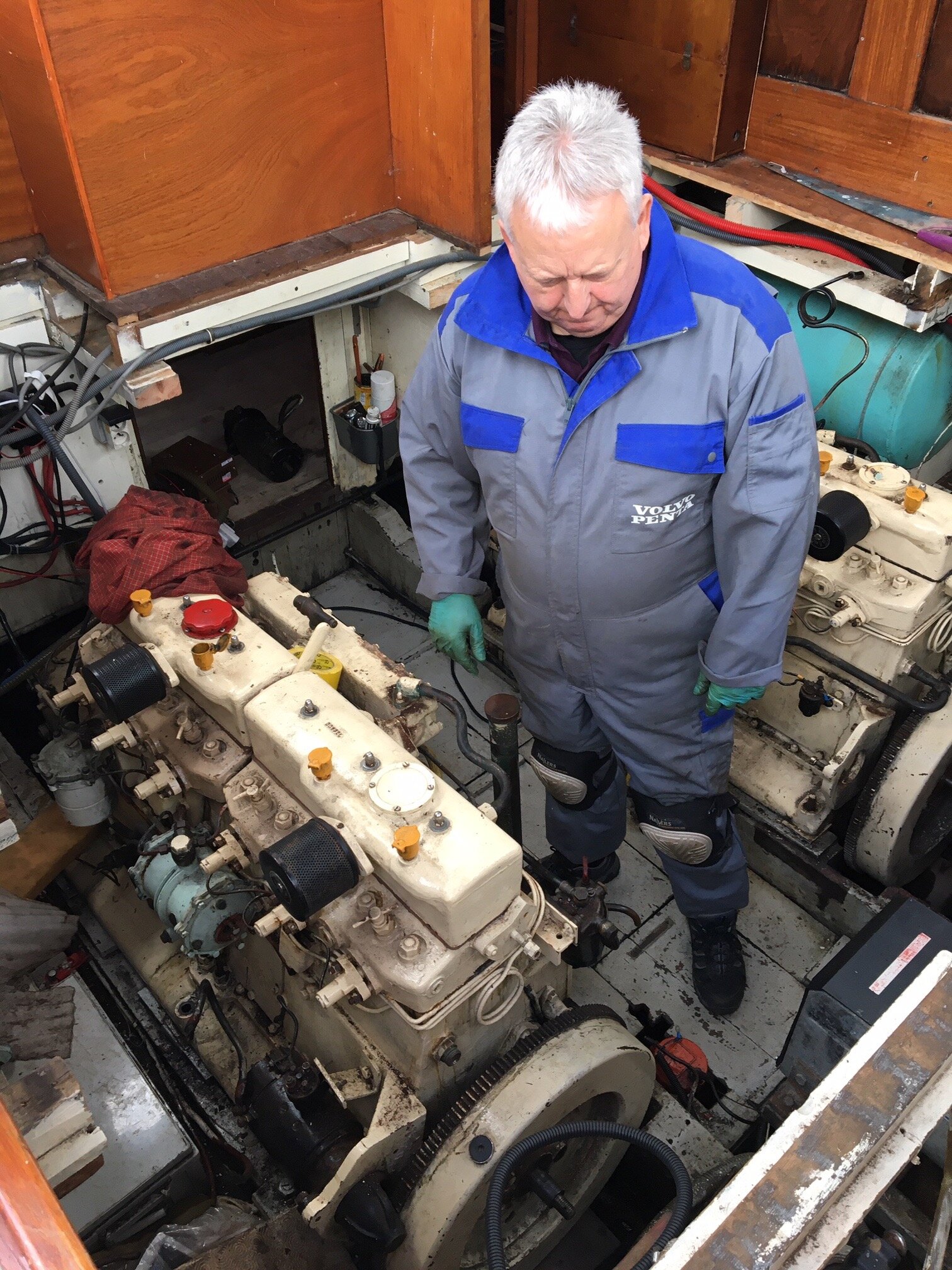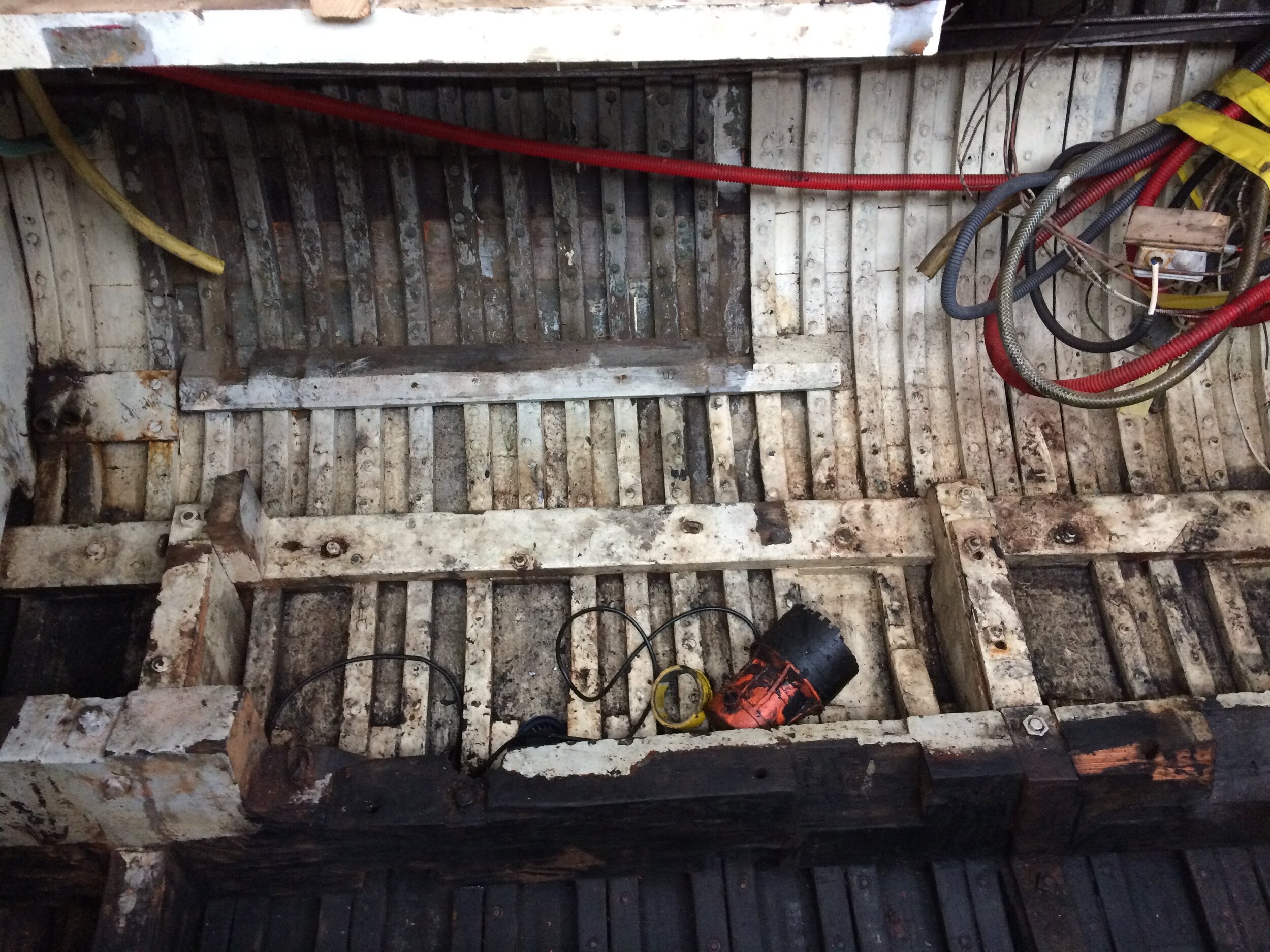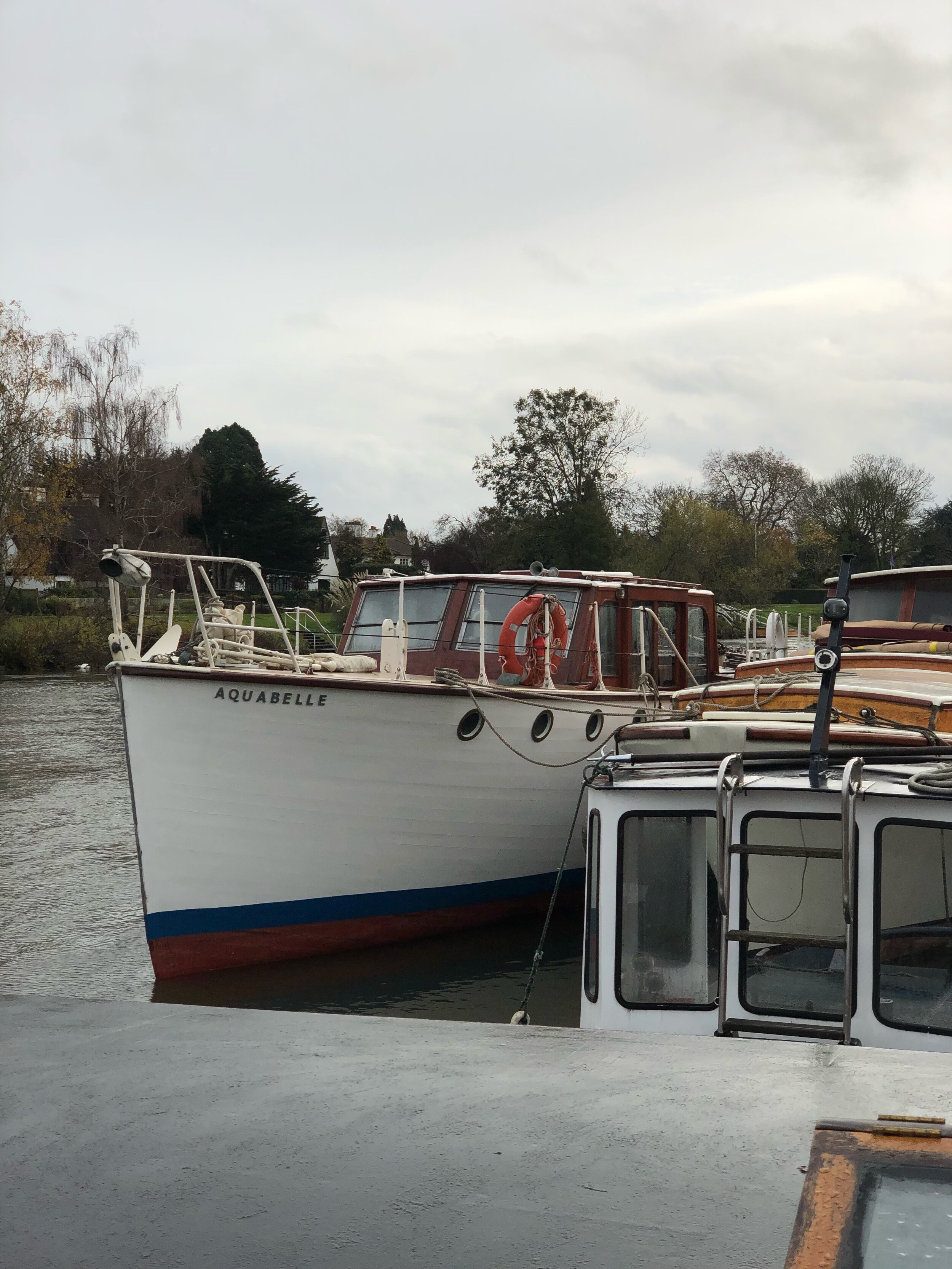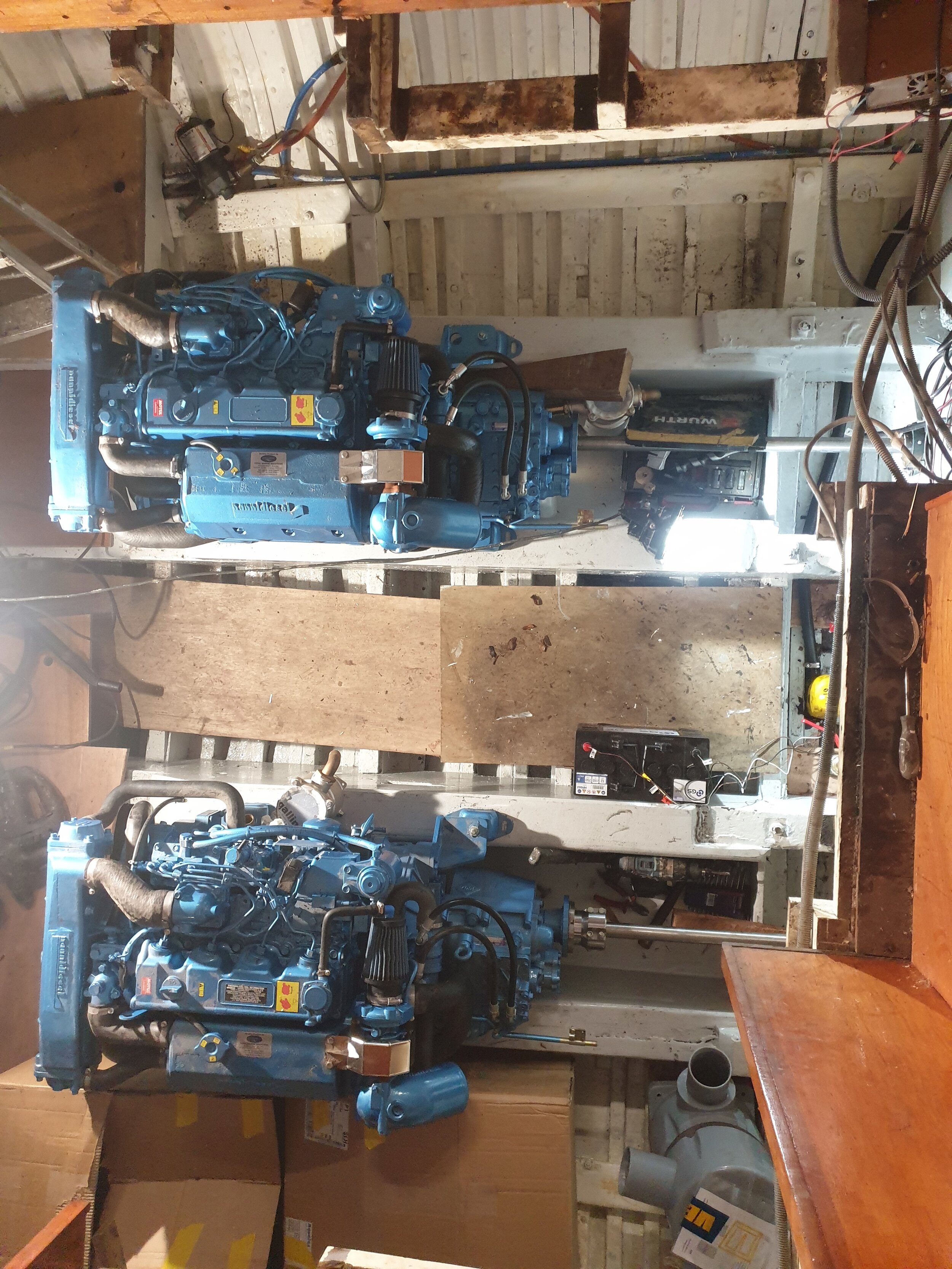Aquabelle’s New Engines
Big Decisions
With Aquabelle’s structure apparently in good condition, we wanted to make sure that her mechanicals were also in the best possible shape to join the flotilla for the 2020 Commemorative Crossings and to take part in other “must do” events later in the summer. Several worrying problems needed to be addressed. Firstly, Aquabelle’s gearboxes showed signs of accelerating wear that could not be adjusted out, leading to frequent problems of gear selection in both forward and reverse. Secondly, her diesel injection pumps were not working properly, preventing smooth running and delivery of full power. Thirdly, her water-cooling pumps required constant oiling and were splashing water into the bilges from failing seals. There was also concern about the longevity of a “fix” to one of her low-pressure fuel pumps and about low engine oil pressure when warm. These issues caused us to worry that Aquabelle could lose power in one or both engines or fail to stop when manoeuvring. Clearly this was a safety concern, particularly with an impending Channel crossing. In addition, the frequent leaking of oil and diesel into her bilges and thence outside meant that she would not be licensable for river cruising. For the same reason we would need to stop the overboard discharge of her toilets and update her gas system for heating water and cooking.
With these factors in mind, we decided that the time had come for Aquabelle to receive a new propulsion system comprising two modern engines with associated gearboxes, shafts and propellers. We could also fix the problems with her water heater and toilets at the same time. Estimates were sought from boatyards local to Palavas and also from a Thames boatyard specialising in “Little Ships” like Aquabelle. It soon became clear that the most cost-effective and lowest risk option was to carry out the work in England using Michael Dennett’s boatyard at Laleham Reach, near Chertsey.
Steve Dennett, the owner’s son and manager of the yard said that, providing Aquabelle could be delivered to him before October 2019, he would have the work completed by March 2020, in good time before the 2020 Commemorative Crossing. With this confidence, a contract was agreed.
Transportation from Palavas to the Thames
As they had given excellent service in 2015, the boat transport company BoatShift was contacted to again convey Aquabelle to England. They tendered a cost only marginally above that of 2015 and so a deal was quickly sealed. An approximate timescale was set which entailed loading Aquabelle, as previously, from Frontignan, around the middle of September 2019. This was organised and agreed but it proved difficult to find a boatyard that was willing to lift Aquabelle from BoatShift’s lorry and lower her into the Thames at a location reasonably near to Dennett’s yard. After being refused by several marinas, including one conveniently located next to Dennett’s because they would not lift wooden boats, a suitable marina was found - Windsor Racecourse Marina. This was swiftly booked before they changed their mind!
Aquabelle’s hull needed to be cleaned and painted before transportation to England because she had accumulated a year’s worth of marine growth over the winter of 2018-2019. She was lifted onto the “Zone Industriel” at Palavas on 26th August for a week of work. Colin flew to Palavas to join the team, which included Alain, Jean-Pierre and Louis. Cleaning involved removing a remarkable volume of barnacles of extraordinary size before applying a coat of anti-fouling below the water line and new white paint above. This was completed by 31st August, allowing the team to enjoy a cruise back to les Quatres Vents in excellent weather. It was considered prudent to return to Les Quatres Vents rather than the summer mooring on the River Lez in case bad weather at sea delayed the crucial voyage to Frontignan next month for collection by BoatShift.
As Aquabelle’s 60 year-old engines were probably unique and were still working, it seemed to be a great shame that their destiny would be to end up in a scrapyard. Colin was aware that another classic yacht, Ruda, had 3-cylinder Ailsa Craig engines similar to those originally fitted to Aquabelle, and that they irrevocably broke down in 2015. The owners donated them to the Museum of Internal Fire near Cardigan in West Wales, where the Ailsa Craig archive is located, but they proved too badly damaged to restore. With this knowledge Colin contacted the museum and offered Aquabelle’s engines to them free of charge if they were willing to collect them from Dennett’s Boatyard. The museum owner, Paul Evans, was grateful to accept them and proposed: “Long term plans for the marine room(s) are to try and re-create a widened version of at least one engine room so that the public pass through/between a pair. The Ruda engines are unlikely to run again without significant effort so your engines would be a good candidate for this display and if possible we would try and replicate as much of the Aquabelle engine room as possible when the time comes”. With this good news all was in place to commence the programme of transport and engineering work.
On the 25th September, Alain and several of his friends took Aquabelle to Frontignan to meet Boatshift’s lorry and so she was lifted onto the vehicle by the marina’s crane in preparation for her long drive. All went to plan and she arrived at Windsor Racecourse Marina on the 30th September to be met by Colin, Sue and Alain (who had flown to England especially to be part of the occasion). By the time they had walked from the Racecourse Marina Café to the crane, Aquabelle was being lowered into the water and moored alongside. We began the complicated task of stripping from Aquabelle all items that could deteriorate over the English winter.
Last Voyage with Aquabelle’s Ailsa Craigs
The next day, Aquabelle and crew descended about 13 miles of the Thames including 5 locks and a spectacular view of ramparts of the magnificent Windsor Castle. The last lock was Penton Hook, after which we made a sharp right turn down a wide cut to find Penton Hook Marina, our overnight stop, appearing ahead. We had just secured Aquabelle and visited the Marina office when a rainstorm broke.
The next morning we continued to remove anything perishable from Aquabelle and ended up with two cars laden with “stuff”. Then Alain and Colin set off back to the main Thames channel and turned downstream. Dennett’s yard soon appeared on the starboard side so we prepared to turn a little further downstream in order to moor alongside one of the boats under repair whilst facing upstream. Unfortunately, during the turn Aquabelle’s stern brushed against a fallen willow tree and, unbeknown to the crew, her flagpole and French National flag were swept overboard and lost. Perhaps a symbol of things to come!
Steve Dennett eventually spotted us as we were mooring up alongside another old boat (called Bateau en Bois) and welcomed us to his boatyard. Alain was fascinated by the general clutter, piles of all types of wood and mixture of rotting and half-reconstructed boats at Dennett’s. This contrasted dramatically with the supreme quality of work very visible in the boats nearing completion. Alain expressed contentment that Aquabelle was in safe and competent hands!
Maiden Voyage
Despite the mess, Stephen Dennett insisted that Aquabelle should have her “maiden voyage” with the new engines. Simply turning of three battery isolator switches to prepare for the voyage then starting each engine with a turn of the key was a new experience!
So, crewed by Colin, Sue, Stephen Dennett and his son Elliott, and Alain Lamens (a Belgian who owns “Breda”, another DLS in Dennett’s Yard), we set off upriver for a short cruise. After a quarter of a mile we needed to turn round rather than go through the lock ahead. Colin conducted the manoeuvre by spinning Aquabelle in her own length without trouble and then she headed downriver, passing Dennett’s Yard on her starboard side. All this was done on engine tickover at an indicated 1000 RPM (later shown to be actually closer to 850 RPM as the dials were a bit optimistic). At this lowest power setting we were running at about 4.5 knots, marginally above the Thames speed limit. Stephen Dennett observed that we were making remarkably little wash so he thought cruising at this speed would not be an issue. In a clear stretch of water Colin briefly opened the engines up to 1600RPM, at which point Aquabelle exceeded 7 knots and her wash was certainly not acceptable! Another straightforward 180-degree turn found us heading back to Dennett’s and, after about 20 minutes sailing we gently came alongside at our previous mooring. Although certainly not silent, the new engines were much quieter than the Ailsa Craigs, free of vibration and hugely more responsive. Helming Aquabelle was now a pleasure!





